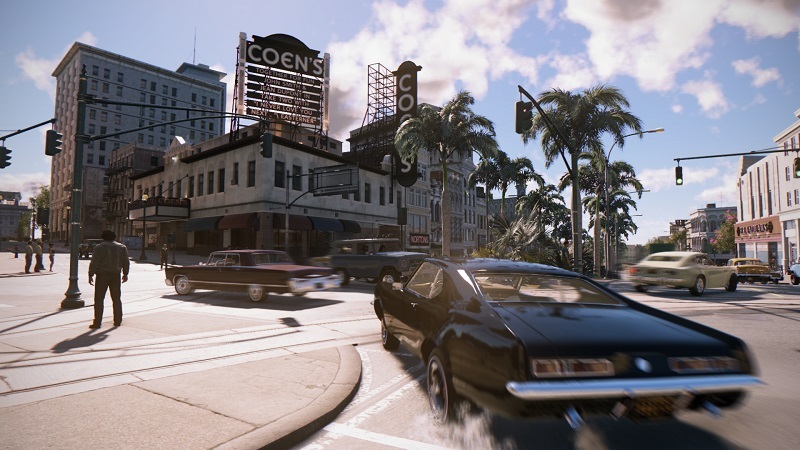Games straddle the line between technology and art. On the one hand, they’re supposed to innovate, challenge and advance the possibilities of their medium. On the other, many of them bank their appeal on making a connection – emotional, skill-based and what have you – with their audience.
If a game fails to push the technological envelope, how much does an individual’s enjoyment of it count towards an overall appraisal? This is a question Mafia III poses to anyone stuck writing a review about it. Mafia III tells a very decent story – at times, a positively daring one – but the game surrounding the narrative feels like it would’ve struggled to stand out on the last generation.
In a way it’s very similar to its two predecessors, only this time, developer Hangar 13 trades the American-Italian mob for organised crime south of the Mason-Dixon Line. Mafia III takes place in an approximation of New Orleans – called New Bordeaux here – and plonks players in the boots of one Lincoln Clay, a mixed-race soldier who returns to his home after a tour in Vietnam. After falling victim to a violent double-cross that leaves his best friend dead, Clay starts making inroads into the city’s underbelly and connecting with underworld bosses he knew before he put on army fatigues for Uncle Sam.
Mafia III Review: The plot’s the thing
The game’s 1960s setting gifts it two remarkable aspects, the first of which is its fantastic presentation. As players tool about in Hangar 18’s Big Easy, the murky mood of the place is conveyed beautifully through period-specific detail and a gorgeous soundtrack featuring some of the best known hits of the era. The occasional visual glitch notwithstanding, New Bordeaux feels like the perfect setting for Mafia III; this is a town where heroes are redundant and those who don’t see fate in a pair of dice are on the back foot.
The second aspect is borne out in the storytelling; given that the 60s was a rather turbulent time in USA both socially and politically, Mafia III is able to is able to use its game’s backdrop to explore issues that most other developers usually steer clear of. The deep south of the time wasn’t exactly what one would call a bastion to tolerance and brotherly love and Clay – and by extension the player – is on the receiving end of racism that is both hostile and at times frighteningly casual. In some instances, certain shops won’t even let Clay enter them – through the front door that is. This narrative asset, incidentally, is never played for cheap preachy points; Hangar 18 simply presents a time in which racism was just a part of life and puts the player in the shoes of those who bore the brunt of it.
Mafia III’s story is its strongest feature and perhaps because though the Italian mobsters here are the antagonists rather than the anti-heroes, the game’s plot is more Goodfellas than The Godfather. Like the psychopaths in Martin Scorsese’s seminal flick, there’s a more ramshackle, edgy feel to the proceedings. Furthermore, the characters in Mafia III manage to be as likable as a bunch of organised killers can be. This is due in no small part to some superb voice acting and a drum-tight script. Even though Clay and his pals have a proclivity for murder, racketeering and general brutality, they still manage to come across as engaging – if not entirely as ‘the good guys’.
Mafia III Review: Grind and grind some more
As great as the setting and story are, however, they’re let down by the game that surrounds them. The mechanics are decent – fistfights feel brutal and the pop-and-cover gunplay is exciting – but progression through the game is locked off behind objectives that are for the most part as dull as dishwater.
In order for Clay to have his revenge, he has to kill the Italian mobsters behind his mate’s death. He does this by weakening their organisation and, in the process, strengthening the positions of his three under-bosses. As his three allies grow in power and he assigns them districts in the city, players unlock nifty aids such as the ability to call in a hit team or ring up for more weapons.
All sounds pretty fun, right? Well the road to being crowned New Bordeaux’s crime kingpin is paved with some of the most mind-numbingly repetitive tasks in current gen games. Busting up rackets, destroying mob assets and killing under-bosses is fun for a bit and then it becomes a boring chore. Players quickly land up in a loop that involves pumping rounds into bad guys, burning a few things and then moving onto the next mini-quest. Players can take a stealthy or direct approach in how they go about some tasks, but this choice isn’t really enough to break up the monotony.
Mafia III Review: Verdict
So how then to judge Mafia III? While progressing through the game was a slog at times, the story and setting made Mafia III shine in places. If you’re a player that demands innovation from every game you experience, Mafia III will feel like a relic. But this game has a great story to tell and, for some players, the drudge-work may be worth it. Don’t do the crime if you’re not prepared to do the time, as they say.
- Mafia III was reviewed on an Xbox One. A retail copy was provided by the publisher.

